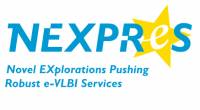Metsähovi Radio Observatory leads the way in Pan-European 4Gbps EC FP7 NEXPReS e-VLBI demonstration
19.09.2013
For the first time Scientific Very Long Baseline Interferometry (VLBI) data recorded at a data transfer rate of 4 Gbps by five participating European stations was successfully correlated in real-time at the Joint Institute for VLBI in Europe (JIVE).
4 Gbps e-VLBI Demonstration September 18, 2013
Scientific Very Long Baseline Interferometry (VLBI) data recorded at a data transfer rate of 4 Gbps by five participating European stations was successfully correlated in real-time at the Joint Institute for VLBI in Europe (JIVE) on September 18, 2013. All stations used modern VLBI hardware and Aalto University Metsähovi Radio Observatory recorded with the FlexBuff commercial-off-the-shelf Linux system developed by the NEXPReS team under the leadership of Metsähovi Radio Observatory. Data transfer at 4 Gbps was enabled by the fast data communications networks in Europe and Africa. Metsähovi Radio Observatory was linked through Finnish University and Research Network (Funet) maintained by CSC.
The Pan-European network
Aalto University Metsähovi Radio Observatory, Finland
Chalmers University of Technology, Onsala Space Observatory, Sweden
Max Planck Institute for Radio Astronomy, Effelsberg Radio Observatory, Germany
National Geographic Institute, Yebes Observatory, Spain
Hartebeesthoek Radio Astronomy Observatory, South Africa
e-VLBI
With e-VLBI, or electronic Very Long Baseline Interferometry, the sampled data is streamed directly from the telescope to the correlator over fibre optic networks and correlated in real-time instead of shipping modules consisting of eight hard disks.
NEXPReS project
Novel Explorations Pushing Real-Time e-VLBI Science (NEXPReS) was a 3-year project funded by the European Commission's Seventh Framework Program (RI-261525). The primary goal of the project was to enhance the performance of the European VLBI Network (EVN) for its partners and users. By introducing a real-time, e-VLBI component to every experiment, NEXPReS aimed to improve the robustness, flexibility and sensitivity of the observations, thereby enhancing the quality of the collected scientific data. Altogether 15 partners took part in the NEXPReS project which consisted of eight separate work packages.
NEXPReS Work Package 8: FlexBuff
Over the 3-year NEXPReS project period, the WP8 FlexBuff team lead by Aalto University Metsähovi Radio Observatory was able to identify suitable commercial-off-the-shelf Linux systems which - when equipped with “matching” data acquisition software - can sustain multiple high-rate read and write streams of network data and offer substantial amounts of storage to locally buffer - acquired data for later processing. Multiple concurrent read/write streaming obliterates the need in VLBI observation planning to predetermine (early, during scheduling) whether a given observation will be correlated immediately while observing (in e-VLBI mode) or later—it even allows reprocessing of an e- VLBI mode observation later with as many recorrelation steps as may be required. The performance of the resulting data acquisition software “vlbi-streamer” confirms that the decisions indeed lead to high streaming performance on COTS Linux hardware.
The created “vlbi-streamer” data-acquisition software is a fully open-source Linux software package available at http://vlbi-streamer.googlecode.com/. Despite its name, it is fully applicable in any data acquisition where UDP data packets are being streamed over a high-speed Ethernet connection (1GE, 10GE).
Contact person:
Laboratory manager Ari Mujunen
e-mail: ari.mujunen [at] aalto [dot] fi
phone: +358-29-4424845
More information about the 4 Gbps demonstration:
http://services.jive.nl/nexpres/
More information about the NEXPReS project:



